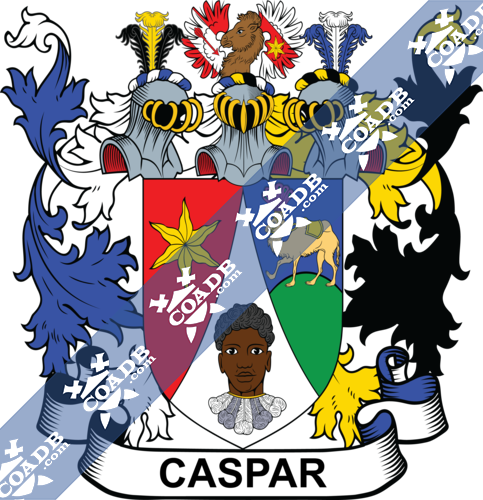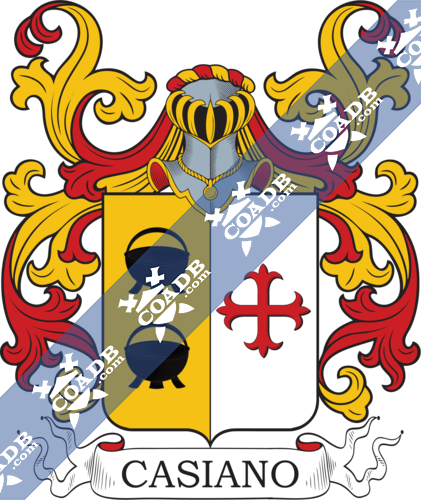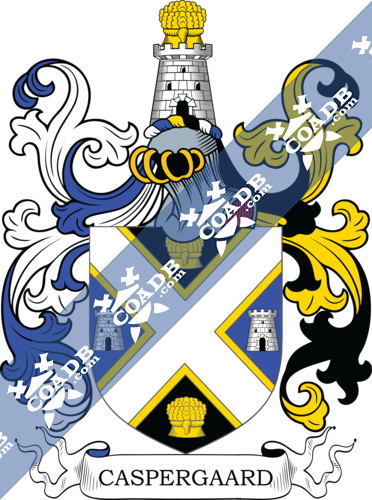Caspar Family Crest, Coat of Arms and Name History

Caspar Coat of Arms Gallery
Don’t know which Coat of Arms is yours?
We can do a genealogical research. Find out the exact history of your family!
Learn MoreThe Polish Caspar surname is of patronymic origin. It is a surname that formed from the first name of the father of the original bearer of the name. The Christian name Kaspar is of Old Germanic origin, acquiring from the Persian word for Treasurer.” More common variations are: Caspari, Caspary, Caspare, Casapar, Casparo, Cuaspar, Caspara, Caspair, Caspaur, Casparie.
The surname Caspar first found in Polesie, the largest county of Poland. It inhabited by Ruthenians, called Polesians, of Ukrainian descent. The main towns are those of Brest Litovsk, Pinsk, Kobryn, Kamenets, Litovsk, and Luninets.
Some of the people with the name Caspar who arrived in the United States in the 17th century included Hans Caspar, who arrived in Carolina in 1734. John Peter Caspar, aged 16, who arrived in Pennsylvania in 1740. Some of the people with the surname Caspar who arrived in the United States in the 19th century included Philipp Caspar, who landed in Brazil in 1823. Ohann Caspar, who landed in America in 1841. John Caspar, aged 45, who landed in Missouri in 1842. Mrs. Caspar, who arrived in San Francisco, California in 1851. Georg Caspar, who came to Texas in 1854. Some of the individuals with the surname Caspar who came in the Canada in the 19th century included Franz Caspar, who landed in Quebec in 1850. Some of the population with the surname Caspar who arrived in New Zealand in the 19th century included Richard Caspar, aged 37, a farm laborer, who arrived in New Plymouth aboard the ship “Halcione” in 1875.
Blazons & Genealogy Notes
1) (Edle von) – Bavière – (Chevaliers du St.-Empire, 26 sept. 1772. M. ét. en 1859) D’argent à une tête de More posée de front portant un collier de plumages le champ chapé-ployé à dextre de gueules à une étoile d’or à senestre d’azur à un chameau au naturel bridé et houssé d’or la tête sommée d’un plumail du même passant sur un tertre de sinople Trois casques couronnés Cimiers 1° trois plumes d’autruche une d’or entre deux de sable 2° la tête et le col du chameau entre un vol l’aile dextre de gueules ch d’une barre d’argent surch d’une flèche de gueules la pointe en bas l’aile senestre d’argent à la bande de gueules ch d’une étoile d’or 3° trois plumes d’autruche une d’argent entre deux d’azur Lambrequin à dextre d’argent et d’azur à senestre d’or et de sable. English: Argent a Moor’s head affronty [facing front] wearing a collar of feathers [all proper I assume], the field chapé-ployé [see https://coadb.slack.com/files/karlwilcox36/F15H7LZ0E/chape-ploye.png] to the dexter gules an etoile or to the sinister azure a camel proper bridle and cover [blanket over the hump?] or the head surmounted by a plume of peacock feathers of the same [the camel] passant on a hillock vert Crowned with three helmets Crest: 1st three ostrich feathers, one or between two sable 2nd the head and shoulders of a camel between a pair of wings the wing to the dexter gules charged with a bend argent surcharged with an arrow gules the point downwards, the wing to the sinister argent charged with a bend gules surcharged with an etoile or 3rd three ostrich feathers one argent between two azure Mantling: to the dexter argent and azure to the sinister or and sable.







